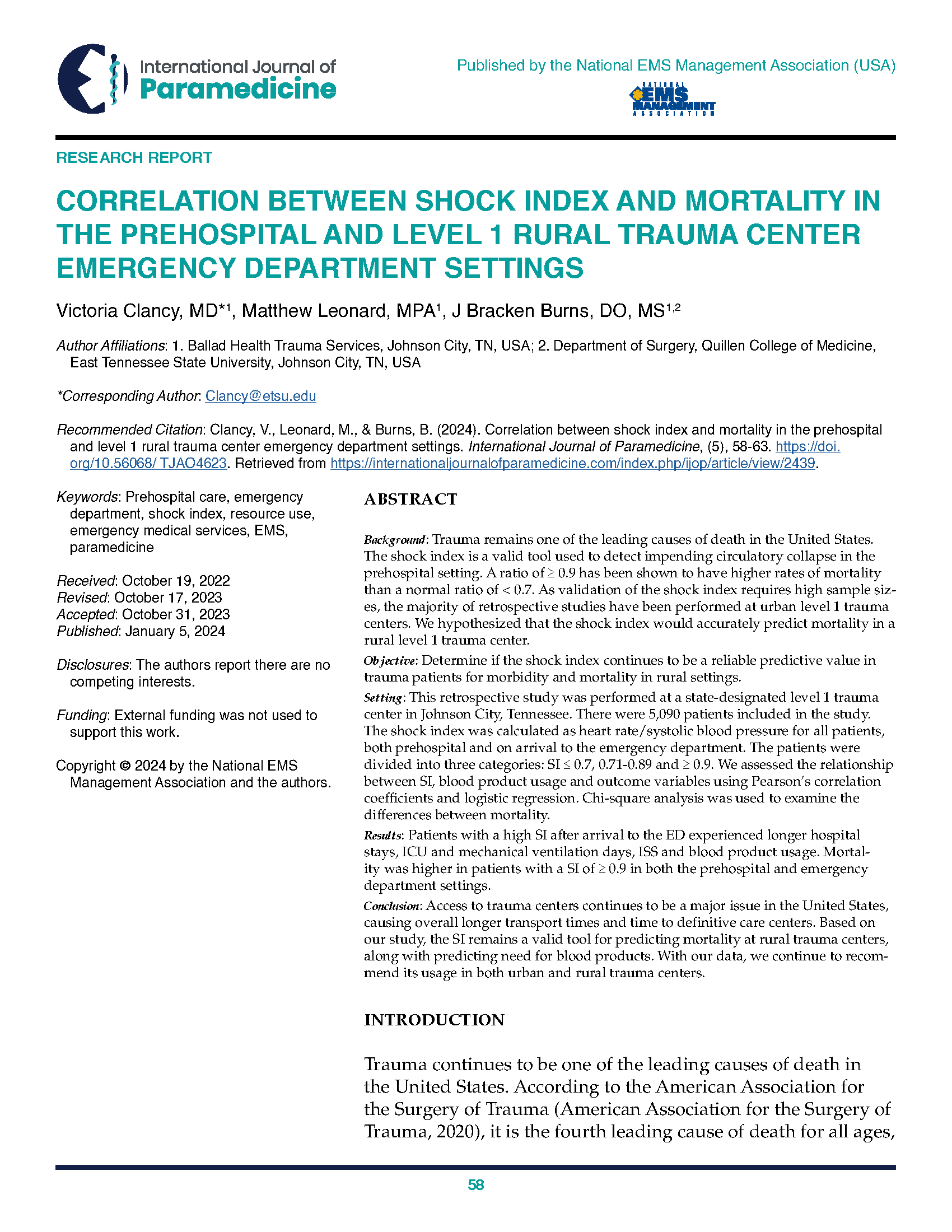Correlation Between Shock Index and Mortality in the Prehospital and Level 1 Rural Trauma Center Emergency Department Settings
Main Article Content
Abstract
Background: The shock index is a valid tool used to detect impending circulatory collapse in the pre-hospital setting. As validation of the shock index requires high sample sizes, the majority of retrospective studies have been performed at urban level 1 trauma centers. We hypothesized that the shock index would accurately predict mortality in a rural level 1 trauma center.
Objective - Determine if the shock index continues to be a reliable predictive value in trauma patients for morbidity and mortality.
Setting - This retrospective study was performed at a state-designated level 1 trauma center in Johnson City, Tennessee. Patients were excluded from the study if they were under the age of 18, not immediately transported to the trauma center or if insufficient data was available. The shock index was calculated as heart rate/systolic blood pressure. Both the prehospital and emergency department shock indexes were calculated, with the emergency department vital signs being the first upon arrival. Patients were divided into three categories: SI ≤ 0.7, 0.71-0.89, and ≥ 0.9. We assessed the relationship between SI, blood product usage, and outcome variables using Pearson correlation coefficients and logistic regression. Chi-square analysis was used to show the difference in mortality between the groups.
Results - A higher shock index score after arrival to the emergency department experienced longer hospital, intensive care unit, and mechanical ventilation days, injury severity scores, packed red blood cells, plasma, platelets, and total blood product usage. Mortality was higher in the groups with an SI of ≥ 0.9 at the scene and arrival to the emergency department.
Conclusion - Patients with a shock index > 0.71-0.89 in both prehospital and emergency departments had higher mortality rates and need for transfusion. The shock index continues to be a reliable predictive value in trauma patients for morbidity and mortality.
Article Details

This work is licensed under a Creative Commons Attribution-ShareAlike 4.0 International License.
Publishing in IJOP allows authors to keep their copyright while giving IJOP unrestricted copyright permissions. Articles published in IJOP use Creative Common Attribution 4.0 International (CC BY-ND 4.0) licensing. This license requires that re-users give credit to the creator. It allows re-users to copy and distribute the material in any medium or format in unadapted form only, even for commercial purposes. Additional terms apply and can be accessed here.
Publishing in IJOP also allows authors to have contracts for non-exclusive distribution of the Journal's published version of the article, such as posting to an institutional repository or publication in a book, on the condition that the original publication in the original layout format in IJOP is retained and acknowledged.
We permit and encourage authors to post the articles they published in IJOP on their affiliated websites. This helps share the information, encourages citation in other works, and promotes scholarly discourse in the spirit of open access.
References
Allgöwer, M., & Burri, C. (1967). "Schockindex" ["Shock index"]. Deutsche medizinische Wochenschrift (1946), 92(43), 1947–1950. https://doi.org/10.1055/s-0028-1106070
American Association for the Surgery of Trauma. 2020 July 22. Trauma Facts and Links. AAST. https://www.aast.org/resources/trauma-facts.
American College of Surgeons. National Guideline for the Field Triage of Injured Patients. 2021 [accessed 2021 Dec] https://www.facs.org/quality-programs/trauma/systems/field-triage-guidelines/.
Eastridge, B.J., Holcomb, J.B., Shackelford, S. Outcomes of traumatic hemorrhagic shock and the epidemiology of preventable death from injury. Transfusion. 2019 Apr;59(S2):1423-1428. https://doi.org/10.1111/trf.15161. PMID: 30980749.
Jehan F, Con J, McIntyre M, Khan M, Azim A, Prabhakaran K, Latifi R. Pre-hospital shock index correlates with transfusion, resource utilization and mortality; The role of patient first vitals. Am J Surg. 2019 Dec;218(6):1169-1174. https://doi.org/10.1016/j.amjsurg.2019.08.028. Epub 2019 Sep 10. PMID: 31540684.
Joaris, O. M., Application of the Shock Index A Predictor of Blood Transfusion (June 15, 2020). http://dx.doi.org/10.2139/ssrn.3654635
King RW, Plewa MC, Buderer NM, Knotts FB. Shock index as a marker for significant injury in trauma patients. Acad Emerg Med. 1996 Nov;3(11):1041-5. https://doi.org/10.1111/j.1553-2712.1996.tb03351.x. PMID: 8922013.
McNab A, Burns B, Bhullar I, Chesire D, Kerwin A. An analysis of shock index as a correlate for outcomes in trauma by age group. Surgery. 2013 Aug;154(2):384-7. https://doi.org/10.1016/j.surg.2013.05.007. PMID: 23889965.
Melnyk M. (May 31, 2009.) Automatic vs. manual BP. JEMS. Retrieved January. 10, 2023, from Automatic vs. Manual BP - JEMS: EMS, Emergency Medical Services - Training, Paramedic, EMT News
Plodr, M., Berková, J., Hy?pler, R. et al. Prediction of pre-hospital blood transfusion in trauma patients based on scoring systems. BMC Emerg Med 23, 2 (2023). https://doi.org/10.1186/s12873-022-00770-x

